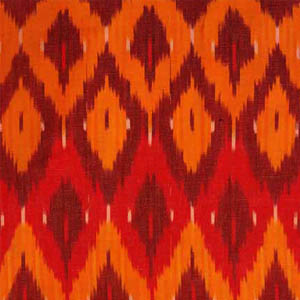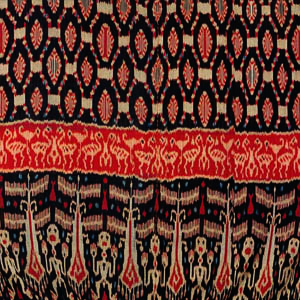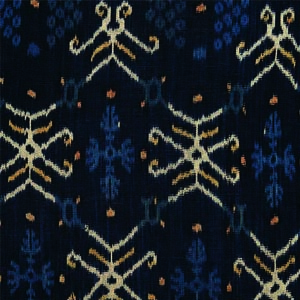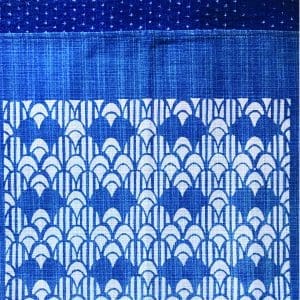HOW IS IKAT PATTERN MADE?





Ikat pattern is a term that refers to a resist dyed weaving technique.
Resist dyeing is a technique that keeps the dye away from selected areas of the fabric or yarn in order to create a pattern or shape.
Ikat pattern is a long resist dyeing process that ultimately ends up as a piece of beautifully woven cloth.
It initially begins by tightly binding bundles of yarn in specific patterns. Then these bundles (hanks) are dyed over and over to achieve the desired colour tones and pattern. In some patterns these ties are untied and then retied and then dyed again in different shades. It can be a very elaborate process to create the base of an ikat pattern. Areas that are tied will not absorb the colour, this is known as “dye-resist”.
The dyeing process varies in different countries. Patterning cloth by combining the design into yarn before weaving.




Ikat pattern is very different from other forms of resist dyeing such as shibori, batik, tie-dyeing and paste resist dyed textiles in general.
Types of Resist dyed textiles:
BATIK – applied resist. This resist is in the form of hot wax and can be applied by brush or more intricately with special spouted metal applicators that give the designer greater control in creating pattern.
This form of resist can be traced back to the 17th Century. And in Japan known as ‘tsutsugaki’ where rice paste is used instead of hot wax. In both cases the wax or rice paste is allowed to dry and then added to the dye pot of colour. Once the cloth has dried after dyeing the resist is removed. The wax is removed by heat and the rice paste by washing.
SHIBORI – Shibori is the Japanese collective word for various types of resist pattern dyeing produced by manipulating fabric – securing it with stitching, binding or AND clamping – before dyeing. The name comes from the Japanese ‘shiboru’, which means to squeeze or wring out. The earliest examples of this technique date back to the 8thcentury. Fabric is drawn up and either bound, stitched, gathered, pleated, folded, clamped or wrapped , compressing the fabric before dyeing.
The beauty of shibori is that fabric can be dyed repeatedly, using different shaping methods, building up colour and pattern. Any pressure on the fabric that doesn’t destroy it will make a mark. The shibori process works in a three dimensional way on a two dimensional surface and can use positive and negative, the front and the back of the fabric. The interaction between the manipulated and plain areas and the proportions of dark and light produce dynamic, subtle effects.
The word ‘Shibori ‘ is a big umbrella for a lot of different methods of creating this type of resist dyed pattern.




Ikat is a more complex type of resist dyeing that requires much planning and consideration even before the weaving begins.
It is an intricate process that requires a great deal of skill and accuracy. Warp and weft yarns can be tied and then dyed before weaving begins. So that when the cloth is woven the ikat patterns reveal themselves on the pre-dyed threads.
Double Ikats – Known as ‘Patola’ in India, are highly treasured ikat fabric as both the warp and the weft yarns are dyed before the loom is threaded – https://make.works/blog/guide-to-weaving




How is IKAT pattern made?
Once all the yarns have been dyed the weaver lines up the threads into his or her pattern. Setting up any loom is a lengthy process, (that I know too well having trained as a weaver for 4 years to acquire my Bachelor of Arts) but this is a more complicated process as the weaver must place the threads exactly as designed in order for the pattern to be woven precisely.
In addition to this process, because of the manner in which the yarn has been resist dyed, it will be hard to replicate exactly the same resist patterns again due to the unique placements of the ties on the yarn bundles before they were placed in the dye.
Different types of IKAT weave structure
https://www.unnatisilks.com/ikat-types-1-indian-crafts.html
What is WARP IKAT?
This is where only the warp yarns are resist dyed or painted with the pattern. The weft yarns are added usually in a single colour.
What is WEFT IKAT ?
This type of ikat pattern is where only the weft yarns ( the yarn that crosses the warp) are resist dyed for the ikat pattern. This is more difficult than the warp dyed ikat because the pattern will develop as the weaving progresses.
What is DOUBLE IKAT pattern?
By far the most complicated of the three types of ikat weaving. This style of ikat pattern is a wonder to behold, especially when you know and understand the processes and time behind each pattern. Only the very advanced weavers have the skills required to create this style of ikat weaving and so the value is reflected as the most expensive of all three ikat patterns.
Step by step ikat weaving process:
The ikat pattern is firstly planned out onto the warp or weft or both threads by hand.
The bundles of threads are then tied and bound to match the weavers pattern.They are then dyed in the chosen colours. Once dry the ties are removed and the yarn is wound onto the loom. If this is the warp or the double ikat fabric technique then this is when the pattern first begins to be revealed.
The pattern is woven and the true shapes of the ikat patterns appear.
Ikat pattern is one of the most complicated woven pattern making techniques because the pattern has to be planned and created on the yarn before weaving can begin.




IKAT WEAVING HISTORY
The history of ikat pattern is not tied to any one country or culture. It is like so many other crafts in life, it seems to have been simultaneously developed in different regions of the world at around the same time. Although it is generally thought to have derived from Indionesia. In Indonesia ikat pattern is known for its beautiful red and indigo patterns woven into the sarongs and shawls associated with their culture.
My love of ikat pattern is in the Japanese indigo versions known as ‘kasuri’ but it was a technique that evolved in many countries – from Japan, to India, Asia, Central America, Argentina to Bolivia.
If you travel to Mexico and Guatemala ikat woven pattern is known as ‘jaspeado’, its main use is for creating the Maya skirts and Shawls.
While in India there are specific weaving communities that specialise in different styles of woven ikat pattern. And fabric qualities vary depending on end use. Silk and cotton ikat patterns are usually designed for saris and veils, while cotton ikats are just for mens ‘lunghi’.
Each country also has its own unique and distinctive weaving ikat style that it is known for, giving ikat pattern a wide pattern repertoire around the globe.
I would love to keep adding to this blog post as it is a fascinating and huge traditional textile technique. I have just touched on the basics to give you a greater understanding of how this stunning type of pattern is created.


